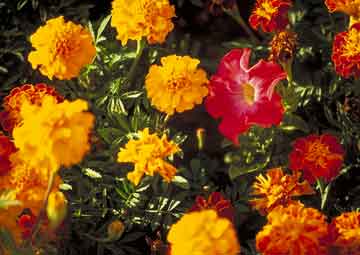Plant a bed of Marigolds this spring, and you’ll discover one of the most rewarding annuals that can be grown in America. No green thumbs are needed to grow armfuls of marigolds. Because of their hardiness they may be planted early in the spring, and will keep blooming right into the cold nights of early November. If you cover them on nights when a heavy frost is predicted, you may have flowers for two or three weeks longer, possibly until Thanksgiving.
Marigold seeds are about a half inch long, black and white. Prepare the soil by spading it and then raking level. Seeds may be planted when the soil is just moist enough to crumble in your hand, but not so wet that it will pack into a mud pie. Sprinkle about an eighth of an inch of fine soil over the seeds and keep the soil moist. The small seedlings will begin to appear in four or five days, and flowers may begin to make color (especially on some of the dwarf varieties) four weeks from the planting date.

Sun Lovers
Marigolds do well in a spot with at least five hours of sunlight each day. When the weather turns dry, water with a thorough soaking as often as needed to keep the foliage from boiling in the hot sunshine. An inch layer of grass clippings will help keep the soil cool and moist, and will discourage weeds. The best flowers come when the weather begins to cool off in late August, and on into the fall when many other flowers have given up the ghost.
Marigolds transplant readily in the seedling stage. Surplus seedlings you may have in the row you have planted may be moved to other parts of the garden or given to your neighbors. Be sure to leave 12 to 16 inches between the varieties that grow large. For the dwarfs, the minimum is four inches for the smallest sorts up to eight inches for those that grow 12 to 18 inches tall.
A guide to buying good kinds of marigolds is to check under their names in a seed catalog to see if they have been an All-America selection. An example of such a prize winner in 1958 was ‘Petite.’ ‘Petite’ came in four distinct color varieties: ‘Yellow,’ ‘Orange,’ ‘Gold,’ and ‘Harmony’ and grew in neat mounds not more than eight inches tall, and flowered scarcely more than three weeks old, if planted in a sunny place after the weather warmed up. It would still be in full bloom at chrysanthemum time.
Use Marigolds to border a walk, in a window box or at the front of your flower border.
African or French Marigolds
Most marigolds are labeled as “African,” or “French.” “African marigolds grow tall and have large flowers; French types tend to be dwarf and to have small flowers. Actually marigolds are traveling under the wrong passports, for they, like zinnias are natives of Mexico. The fact that both marigolds and zinnias originated close to home is probably the reason they are so well adapted to this continent, and so easy to grow in every garden.

Marigolds and mocking-birds have something in common- the flowers of modern marigolds may be like a dahlia, or with the petal formation and size of a football mum. Some varieties look like a carnation, others like a lilliput zinnia, and the African types may resemble a peony. They grow from six to 36 inches tall. Different types are suited to any part of the border from the tiniest edging to horsey background plants. Marigolds make long – lasting cutflowers. lf you object to the pungent odor of marigolds, varieties with odorless foliage are available.
So There is No Confusion
“Man-in-the-Moon’ marigold is a tall African variety that bears an abundance of solid, round, carnation-like blooms composed of broad, crisply ruffled, taffeta-like, pale moon-yellow petals with much lighter highlights. Not to be confused with the movie – The Effect of Gamma Rays on Man-in-the-Moon Marigolds – directed by Paul Newman
It was the nearest thing to a pure white rnarigold. One seed house offered $10,000 cash prize to the person who saved seed of a marigold that produced a plant with snow-white double blooms the size of those of “Man-in-the-Moon.”
Volunteers and Diseases
Marigolds may send up volunteer seedlings from seeds dropped from last year’s blooms. While these “free” plants sometimes turn out to be excellent performers, the chances are that they will be a disappointment. The reason is that only the hardiest are likely to volunteer, and this often means a return to the wild form – plenty of plant vigor, but disappointing flower color (ever notice how volunteer petunias revert to muddy magenta?) or flower form (doubles turn back to singles). It is best to weed them out and to plant fresh, quality seeds each year.
Marigolds bloom longer and more profusely if the old blooms are removed to prevent the plants from going to seed.
The “aster yellows” disease may attack marigolds. The plants become dwarfed, the old leaves turn reddish, and there are numerous sickly-yellow new shoots. Blooms turn greenish. Pull out and destroy the affected plants. Leaf hoppers may cause these same symptoms, however, and they can be controlled fairly easily.
Marigolds will provide wonderful color in a window box that faces south, southwest or west. Combine dwarf varieties with white flowered geraniums and a black-purple flowered petunia. If you are sensitive to clashing color combinations, don’t plant orange or mahogany colored marigolds with red geraniums, pink petunias, or with a lavender periwinkle. Likewise, mahogany colored marigolds clash in the worst manner with a red brick house.
